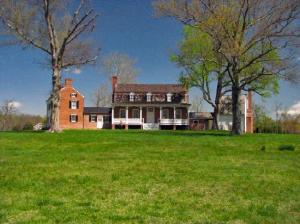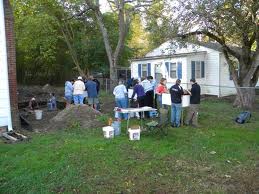
Port Tobacco was not on the water when I visited.
Prior to the American Revolution, this Maryland hamlet barely an hour’s drive south-east of Washington, DC was the second largest seaport in the American colonies. Ships anchored to be loaded with barrels of tobacco bound for Europe and the rest of the world. Port Tobacco was on the world map.
In recent decades the nearest water to Port Tobacco was a marshy stretch where archeologists are examining residue for shoe buckles, clay pipes and artifacts from the original settlers in this area, Algonquian-speaking tribal peoples. Hardly enough water near Port Tobacco to support a kayak hull, let alone a blue water schooner. But that’s changing, thanks to community involvement in river restoration efforts and the Port Tobacco River Conservancy
The Catholics arrived in 1658, the Episcopals next. One hundred defined lots originally made up the town limits, but the port was growing each year. By 1819 the community built the courthouse

, now a museum. Inside, only one original furniture piece remains, the clerk’s oak desk. The St. Charles Hotel could seat 200 for dinner. Sales of enslaved people for Southern Maryland plantations took place on the auction block outside the courthouse. Sixty business and homes were listed within the incorporated area.
Tobacco was the local currency. For the European market, the leaves were packed in kegs and shipped to England. Most of the merchants were Scottish sea farers. Merchants offered credit to plantation owners and it was the merchant’s responsibility to get the tobacco to Europe and England, taking their pay from the proceeds. Surely agents, scrupulous and not, handled the sales paperwork and letters of credit.
Back in the day, there were more enslaved people of color than whites of European ancestry in the region. After the Revolutionary War, the circuit court system was left in disarray. The circuit court met every three or four months and the arrival of the judicial entourage signaled the opening of a fair, the market and trade season when people gathered in town to witness trials and punishments. That was public entertainment of the era — exhibitionists in the stocks, blasphemers pilloried. Doubtless there were worse punishments wrought.
Two newspapers operated in the town, the Port Tobacco Times and the Times Crescent. The Maryland Independent, a relative newcomer, remains.
Warehouse Landing Road marks the location of the largest tobacco barn in the area, where they grade tobacco grown in Charles County. During the 1920s, there were swimming camps (called bathing camps at the time) for children all along the river. In 1940, the Society for the Restoration of Port Tobacco formed to preserve and protect this landmark settlement. Catslide House was renovated. In the 1960’s, archeology dig led by the Smithsonian Institution excavated artifacts now displayed in the museum. Elaine Racey, a Courthouse guide, dropped hints about a local ghost while Dorothy Barbour, a docent working in the gift shop, said that more artifacts might be available for display in the museum if a private foundation could be persuaded to sponsor a

fixed temperature display area. Dr. Barbour owned Stagg Hall, one of several historic manor houses in the area.
How did Port Tobacco lose its waterside supremacy? Over the centuries, plantations from here to the Potomac River cleared the trees and plowed the fields for a mono-crop, poor soil management causes erosion which silted up the waterways. Even in the 21st century, storm water runoff and erosion are primary culprits in the degradation of the Port Tobacco River Watershed and Maryland’s coastal wetland port.
Notable figures from this area include:
* Wat Bowie and Mosby’s Men
* Dr. Gustavus Brown, one of George Washington’s doctors, who hastened George Washington’s death with numerous bleedings
* Olivia Floyd of Rose Hill, a spy for the Confederates during the American Civil War
* John Hanson, President of the First Continental Congress
* Matthew Henson, co-discoverer of the North Pole, born near Nanjemoy, Md.
* General Wm. Smallwood, a Revolutionary War leader
* Thomas Stone, a signer of the Declaration of Independence
If you’re interested in the Revolution and its aftermath in Port Tobacco and the surrounding area, I highly recommend Jean B. Lee’s book _The Price of Nationhood_ (W. W. Norton). Well worth reading.
Thanks for the suggestion. I will look for Jean Lee’s book!
Hello! I teach at the College of Charleston, SC and this semester I am teaching a course on travel writing. We are using your book “Travel Writing: See the World, Sell the Story.” In Ch. 5 you mention a piece you wrote about kayaking in Coastal South Carolina. I’ve been desperately trying to find that piece to share with my students. Might you know where I could find a copy? Thank you so much!
I’m a Virginia native, growing up outside of Washington, DC, so I’ve enjoyed your posts about DC and Maryland!
Hi Jessica, Sorry it took so long to return your query. Coastal Kayaking in So. Carolina appeared on a travel website http://www.travelhat.com back in Nov. of 2002. I just searched for it and I think the site no longer exists. fyi, the url was http://www.travelhat.com/travel/store/2462.html in case you want to search the way back archive or whatever the current name is for the internet archive.
On the other hand, I could scan it and send it to you. Alas, the printed version of the page layout is also archaic so the header appears on each printed page, as well as sponsored links and ads.
Good thing I try and print out copies of my online publications and reviews. Do pass on that tip to prospective travel writers in your class! So much online material is here today and gone tomorrow.
Let me know if this scan/send will work for you. If you like, I could do a skype talk with the class if you think it would be of interest and you have the connective ability in the classroom . Just a thought….
Cheers, Peat